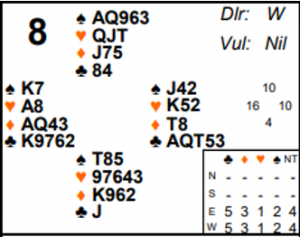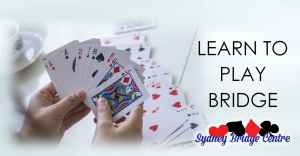City and Canada Bay – Monday Morning 1st July 2024.

Last week on board 8, despite having a combined 26 points, a large number of East West pairs didn’t manage to bid to 3NT. I suspect one reason for this might have been the choice of opening bid.
If West opens 1♣, North is likely to overcall 1♠. Now East needs to show that he has a good club raise. A good way to do that is to bid 2♠, a “cue raise”. This shows a better hand than just bidding clubs immediately (so a jump to 3♣ can then be played as weak pre-emptive). A cue raise is normally played as at least an invitational raise (so about 10+ points). Opener initially assumes it’s just an invite and makes a minimum rebid with nothing extra. Then the cue raiser can pass or go on as appropriate. Or opener can force to game if they are better than minimum – i.e. would have accepted an invite.
Quite a few pairs seem to have played in 3♣ so I imagine East raised but West didn’t know how strong his partner was. That’s why it’s important to be able to distinguish between a “good” raise (with values) and a weak raise which is more pre-emptive in nature. Also if East just raised to 2♣ then South, given his singleton club, might have joined in with 2♠. Now it’s looking less appealing for West to try no-trumps with a pretty weak stopper and his partner potentially only holding 5 or 6 points.
Once West finds out that East has a good raise then, holding 16 points himself, he knows that the pair belong in game – the only question is which one?
One possibility is just to try 3NT immediately – after all you have ♠Kx which will be a sure stopper from your side. This works well on the hand – because 3NT can’t be touched. Another option might be to explore further with 3♦ – this is essentially natural but shows values there. This is because you are hoping to reach 3NT if your side has stoppers in all the other suits. That’s a good approach after raising a minor since you want to play 3NT if at all possible – you only want to play in 5 of a minor as a last resort since it scores so much less.
After 3♦ East might bid 3♥ which will in turn show a heart stopper – East almost certainly won’t have 4 hearts though because he would surely have doubled after 1♣ 1♠ if he did. He also won’t have a spade stopper (if he had both a heart and a spade stopper he could just bid 3NT himself). Once again that will lead West to bid 3NT and East, holding nothing more than he has already shown, will happily pass. See advanced section for more about stopper bidding – in a contested auction it can be confusing which bids SHOW stoppers and which bids ASK FOR stoppers.
There is, however, arguably a better way to reach 3NT which avoids all that! Even though West has a 2245 shape there is a lot to be said for simply opening a 15-17 1NT. For lots of reasons:
- It describes the broad nature of your hand in one bid.
- You have honours (and stoppers for no-trumps) in every suit.
- It takes up the whole 1 level and makes it much riskier for the opponents to overcall.
- Your two suits are the minors so you are less likely to miss a major fit by doing this.
- If you do open 1♣ and partner responds 1 major, what will you rebid? 2♦ I suppose – but you are pretty minimum for a reverse (i.e. forcing partner to go back to 3♣ if he prefers clubs) and it doesn’t really feel that descriptive since you don’t have that much shape and neither suit is particularly good quality.
- If means you are more likely to be declarer (partner will transfer to a major if he holds one) – and that’s probably a good thing as it means the lead is going to be coming around to the honours in your hand rather than through them.
Of course as with any choice of bid there can be downsides – here partner may well transfer to one of your doubleton majors. But that may still be OK. Firstly he might have a 6 card major himself, secondly a 5-2 fit may still play alright and you have a potentially unexpected ruffing value in the other major anyway! What’s more after a transfer sequence that extra doubleton will be in your own hand and not visible to the defenders so it may not be clear for them to play trumps in time.
If West does open 1NT the auction may just be a simple 1NT P 3NT (although East might still enquire about majors if it’s possible for West’s 1NT to contain a 5 card major since a 5-3 fit there might play well). North won’t be able to risk overcalling 1NT with 2♠ now with a balanced hand and only 10 points. At the 1 level it’s very different (especially over 1♣ as 1♠ means you are now the one taking up the opponents’ bidding space).
There isn’t much to the play or defence on this hand. 3NT cannot be beaten – declarer has 5 clubs, 2 hearts and 1 diamond on top. He will either score a spade or have time to take a winning diamond finesse.
The most likely outcome is 9 tricks after a low spade lead from North. Now declarer will almost certainly cash his 9 tricks. Unless North throws too many spades away on the run of the clubs, declarer cannot afford to risk a diamond finesse since if it loses North will be able to beat the contract with winning spades.
On a non-spade lead declarer can now cash 5 clubs and take a diamond finesse knowing that even if it loses North still can’t attack spades. When it wins that’s also 9 tricks.
Just one hypothetical play question as declarer. Suppose you only had 9 clubs not 10 (remove either the ♣2 from West or the ♣3 from East). How should you play that club suit and why?
Key points to note
- With a minor suit fit look to play 3NT first if possible – playing in 5 of a minor should be the last resort at pairs.
- Playing cue raises (a bid of the opponent’s overcall suit shows a good raise of partner) is very helpful in the auction later.
- Consider what bids (either new suits or suits the opponents have bid) show and what bids ask for stoppers for no-trump purposes.
- Opening 1NT slightly off-shape can be quite effective for lots of reasons.
More advanced
A holding like Kx in a suit the opponents have bid is sometimes referred to as a “positional stopper” – if you are declarer it’s a stopper but if you are dummy it might not be as the suit can be led through. On this hand East West have a spade stopper regardless – but suppose East had had ♠Jx not ♠Jxx – now it would be essential for West to be declarer in no-trumps.
When a hand raises a minor it normally means they won’t hold a major because they would have shown that first. So later bids in a major tend to just show values (stoppers) there. Of course if your partner shows values in one suit and you have stoppers in the others you can bid 3NT. But if it looks like neither of you have a stopper in a suit then it’s not safe to play no-trumps and you may have to resort to 5m.
Sometimes, however, you want to be able to ask if partner has a stopper instead. That is like 4th suit forcing. When your side has bid 3 suits already if you had a stopper in the 4th suit you could just bid no-trumps yourself. So it’s logical that a bid of that suit this time asks partner if they have a stopper.
If the opponents have bid a suit, then frequently a later bid in that suit will be asking for a stopper for this reason. But what if the opponents have bid two suits? It can be played either way around but what I normally do is play that when they have bid two suits and we bid them we SHOW a stopper there and partner can now bid 3NT if he can stop their other suit.
So on this hand after a start 1♣ 1♠ 2♠ (cue raise) then a bid of 3♠ would ask for a spade stopper, and bids of 3♦ or 3♥would be natural’ish (in West’s case 3♥ would likely be natural but in East’s case it would just be a stopper – as East has pretty much already denied holding 4 hearts when his first action was to raise clubs rather than make a negative double).
What if you have a really good hand and are interested in slam? Don’t you want to be able to cue bid in suits instead? Yes – but sometimes you can do both! You have to plan ahead though. You might initially make a bid showing a stopper but then when your side reaches 3NT you NOW continue with 4 of the minor. That’s showing slam interest (you’d never remove a game bid to a partscore). So that might indicate that your previous bid was in fact what’s known as an “advance cue bid” – it was bid at the time knowing partner would take it as a stopper but when you later show slam interest then partner can re-evaluate the auction.
Lastly I posed a hypothetical play problem in the club suit. How should you play with ♣K976 opposite ♣AQ1053? The answer is to cash the ♣A first – that way you leave a top honour in both hands so if either hand proves to have ♣Jxxx you can still pick the suit up. If you were to cash the ♣K first and find ♣Jxxx sitting over ♣AQ1053 then you can no longer make 5 tricks. It’s just about thinking what is the worst that could happen in the suit and then considering if there’s anything you can do about it. But note that this is subtlely different to ♣K976 opposite ♣AQ853. This time you are missing ♣J10xx and you can’t pick that up at all if it’s over the ♣AQ853 but you CAN pick it up if it’s over the ♣K976. But only if this time you cash the ♣K first! Why? So that you retain two top honours over the remaining ♣J10x and, entry permitting, can lead up to them twice more to avoid any losers in the suit. The ♣10 makes a big difference!
Julian Foster (many times NSW representative)



